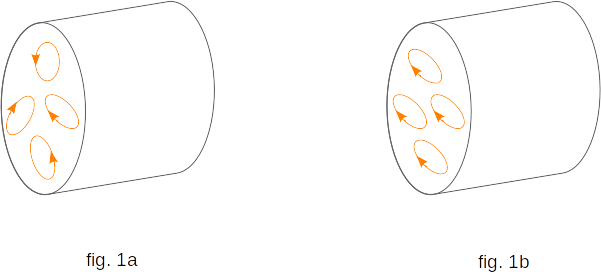From the Magnetic properties of the substance
141. Ampere's hypothesis
We know that the vector of magnetic induction \(\overrightarrow{B}\), created by a current in a substance other than in a vacuum. If in vacuum currents create magnetic induction \(\overrightarrow{B}{_0}\), in a homogeneous medium the magnetic induction is
\( \overrightarrow{B} \,= \,\mu\overrightarrow{B}{_0} \) (13-1)
where \(\mu\,\) is the magnetic permeability of the medium.
We emphasize that equation \((13-1)\) is only true for a homogeneous medium that fills the entire space, or for cases of special symmetry of parts of the substance, such as for a homogeneous rod inside a solenoid. If a part of the substance is of an arbitrary shape, the induction inside the substance will not be equal \((13-1)\) when it is placed in a magnetic field with induction \(\overrightarrow{B}{_0}\). The dependence between \(\overrightarrow{B}\) and \(\overrightarrow{B}{_0}\) is much more complex and is determined by the shape of the part of the substance and its orientation in relation to \(\overrightarrow{B}{_0}\).
The reason why bodies have magnetic properties was first found by Ampere. At first, under the direct impression of observing a magnetic arrow rotating near a conductor with a current in Oersted's experiments, Ampere suggested that the magnetism of the Earth is caused by currents flowing inside the globe. The main step was made: the magnetic properties of the body can be explained by the currents circulating inside it. Then Ampere came to the general conclusion: the magnetic properties of any body is determined by closed electric currents inside it. This decisive step from the possibility of explaining the magnetic properties of bodies by electric currents to the categorical statement that magnetic interactions are in all cases is the interaction of electric currents - proof of the great scientific courage of Ampere.
According to Ampere's hypothesis, elementary electric currents circulate inside molecules and atoms. (Now we know that these currents are formed by the motion of electrons in atoms.) If the planes in which these currents circulate are arranged chaotically in relation to each other (fig. 1a), their action is mutually compensated and the body does not detect any magnetic properties. In the magnetic state, elementary electric currents in the body are oriented in a strictly defined way, so that their actions are summed up (fig. 1b).

At present, the fairness of the Ampere hypothesis is proved by direct experiments.